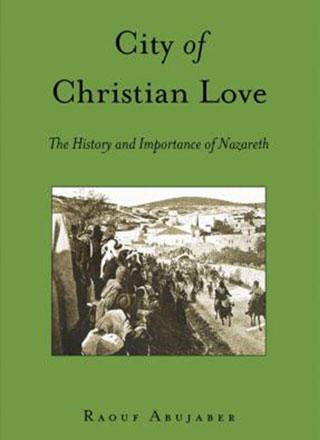You are here
300 years of communal harmony
By Sally Bland - Dec 03,2017 - Last updated at Dec 04,2017

City of Christian Love: The History and Importance of Nazareth
Raouf Abujaber
New York: Peter Lang, 2017
Pp. 129
Raouf Abujaber, author of this brief but beautifully rendered book, has had a long, prolific career as historian, businessman, educator and community leader. He was among the first to introduce into Western academia the study of Jordanian society as a field in its own right, with his book, “Pioneers over Jordan” (I. B. Taurus, 1989). This new book on Nazareth makes thirteen books he has published, some in Arabic, some in English.
In the preface, “Reflections from a Childhood in Transjordan”, Abujaber confides that his ties to Nazareth are personal as well as being academic and related to his Christian faith, for his mother came from there, moving to Salt when she married his father. “Although she remained, all her life, a proud Palestinian, she also became a Jordanian… In my childhood my mother used to tell us, at the fireside during those cold evenings, about her life in Nazareth and the chronicles of her birthplace. She spoke highly of Dhaher Al Omar and was proudly enchanted with the friendship and good neighbourly relations with the families around them without distinction between Muslim and Christian.” (p. xvi)
While Nazareth’s distinction in maintaining Muslim-Christian harmony is the predominant theme, a subtheme is the closeness, near-oneness, of Jordanians and Palestinians.
From the early Christian era up to the 1948 occupation, Abujaber traces Nazareth’s shifting fortunes and development under a chain of rulers — Roman, Byzantine, Persian, Arab-Muslim, Crusaders, Ayyubids, Mamluks, Ottomans, etc. Most often, its fate was connected to that of the Galilee and northern Palestine as a whole, but occasionally it was singled out, as when the Ottoman Turks, allied with Germany in World War I, made it their military headquarters. Although this led to construction and provided jobs, overall, the war brought more hardship than benefit to the locals.
In the course of his historical review, Abujaber introduces a variety of sources, from Roman historians and local scribes to accounts by Western travellers, pilgrims and missionaries, most of whom visited Nazareth during their trips to the Holy Land.
Referring to the first century AD, the author notes: “Nazareth of Galilee, in these times, must have been a village of no importance, but it was the place where Jesus Christ… lived with his mother Mary, wife of Joseph, the carpenter. Although of little strategic or economic importance, the Jewish and Christian scriptures allude to the spiritual importance of the Galilee region.” (pp. 1-2)
In view of Nazareth’s modern-day size and significance, one is surprised to learn how long it remained a small and negligible town. According to Abujaber’s account, it was first under Dhaher Al Omar’s rule that it gained some advantages, save for the building of a few churches during Byzantine times, and its elevation to a bishopric under the ruler Tancred in 1109. While the Crusades attracted attention to Nazareth, the Crusaders viewed the indigenous Orthodox Church with suspicion, as it did not comply with Latin policies; also local Christians were sometimes viewed with suspicion by Muslims due to their real or imagined connections to the Crusaders. In the battles between the Crusaders and local Muslim leaders, churches and monasteries in nearby Mount Tabor were destroyed and those who did not convert to Islam were killed.
Such insecurity was only ended decisively when Dhaher Al Omar established his principality in northern Palestine. Thousands of Nazarenes joined in the battles to establish his rule, and Nazareth grew and became a commercial centre. Dhaher Al Omar also granted the Orthodox community the right to their own church.
The 19th and early 20th century was a time of relative prosperity and witnessed the building of many churches, schools, orphanages and hospitals, mostly funded by churches abroad, and accessible to Muslims as well as Christians. The book includes descriptions of these institutions, the various Christian communities and religious orders, and their churches, as well as interesting historical photos of landscapes, monuments and important documents.
The historical narrative ends with the fall of the Galilee to the Zionist forces in 1948. Complicating the job of historians, Nazareth’s 14-volume register disappeared, erasing records of 130 years of daily transactions, which had been supervised by judges of the Fahoum family. Yet, Christian-Muslim solidarity persisted, based on the 1854 “cousinship” pact signed by the leaders of the two communities, at a time when sectarian strife was occurring in other parts of Bilad Al Shem.
Besides highlighting Nazareth for its beauty and historical significance, Abujaber’s book conveys a timely message on the merits of religious tolerance, holding out the town’s example of people who “have lived together during the last three hundred years with an air of amity between them and a feeling of pride that has been transmitted from generation to generation”. (p. 114)
Related Articles
AMMAN — Noted historian Raouf Abu Jaber will launch his new book "Nazareth — City of Christian Love" at the National Library in Amman on Thu
AMMAN — A book on interfaith relations by noted historian Raouf Abu Jaber “Nazareth — City of Christian Love” was launched at the National L
AMMAN — HRH Prince Hassan, chairman of the board of trustees of the Royal Institute for Inter-Faith Studies (RIIFS), has greeted Christians

















